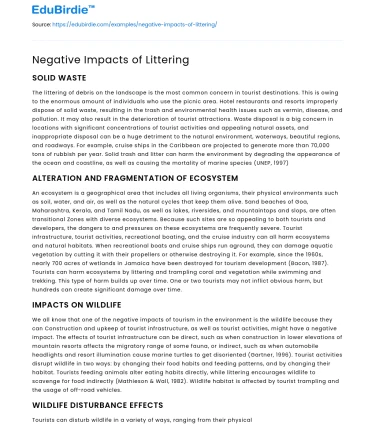SOLID WASTE
The littering of debris on the landscape is the most common concern in tourist destinations. This is owing to the enormous amount of individuals who use the picnic area. Hotel restaurants and resorts improperly dispose of solid waste, resulting in the trash and environmental health issues such as vermin, disease, and pollution. It may also result in the deterioration of tourist attractions. Waste disposal is a big concern in locations with significant concentrations of tourist activities and appealing natural assets, and inappropriate disposal can be a huge detriment to the natural environment, waterways, beautiful regions, and roadways. For example, cruise ships in the Caribbean are projected to generate more than 70,000 tons of rubbish per year. Solid trash and litter can harm the environment by degrading the appearance of the ocean and coastline, as well as causing the mortality of marine species (UNEP, 1997)
ALTERATION AND FRAGMENTATION OF ECOSYSTEM
An ecosystem is a geographical area that includes all living organisms, their physical environments such as soil, water, and air, as well as the natural cycles that keep them alive. Sand beaches of Goa, Maharashtra, Kerala, and Tamil Nadu, as well as lakes, riversides, and mountaintops and slops, are often transitional Zones with diverse ecosystems. Because such sites are so appealing to both tourists and developers, the dangers to and pressures on these ecosystems are frequently severe. Tourist infrastructure, tourist activities, recreational boating, and the cruise industry can all harm ecosystems and natural habitats. When recreational boats and cruise ships run aground, they can damage aquatic vegetation by cutting it with their propellers or otherwise destroying it. For example, since the 1960s, nearly 700 acres of wetlands in Jamaica have been destroyed for tourism development (Bacon, 1987). Tourists can harm ecosystems by littering and trampling coral and vegetation while swimming and trekking. This type of harm builds up over time. One or two tourists may not inflict obvious harm, but hundreds can create significant damage over time.
Save your time!
We can take care of your essay
- Proper editing and formatting
- Free revision, title page, and bibliography
- Flexible prices and money-back guarantee
IMPACTS ON WILDLIFE
We all know that one of the negative impacts of tourism in the environment is the wildlife because they can Construction and upkeep of tourist infrastructure, as well as tourist activities, might have a negative impact. The effects of tourist infrastructure can be direct, such as when construction in lower elevations of mountain resorts affects the migratory range of some fauna, or indirect, such as when automobile headlights and resort illumination cause marine turtles to get disoriented (Gartner, 1996). Tourist activities disrupt wildlife in two ways: by changing their food habits and feeding patterns, and by changing their habitat. Tourists feeding animals alter eating habits directly, while littering encourages wildlife to scavenge for food indirectly (Mathieson & Wall, 1982). Wildlife habitat is affected by tourist trampling and the usage of off-road vehicles.
WILDLIFE DISTURBANCE EFFECTS
Tourists can disturb wildlife in a variety of ways, ranging from their physical presence to their movement, noise, and conduct. Different species will react to the resulting disruption in various ways and for various causes. Various species, situations, and times will have different levels of wildlife tolerance and response, as well as any adverse consequences. Different eating patterns, territoriality, breeding seasons and behaviors, lifecycle maturity, alarm behaviors, and ecological niche competition can all contribute to these variances. Some visitor effects, such as passing trampers, may be incidental to wildlife, whilst others, such as ecotourism visits or photography, may be targeted particularly at wildlife. Additional visitor-related consequences can result from how wildlife reacts to the presence of workers; any accompanying construction, maintenance, or research operations; and the impact of the presence of buildings and structures.






 Stuck on your essay?
Stuck on your essay?

